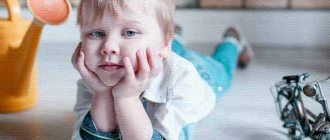Level 3 OHP is characterized by moderate deviations in speech development. The vocabulary is good, the child speaks in fairly complex sentences, but pronounces sounds incorrectly. In this regard, others often do not understand what he is saying. There are other problem areas that need to be corrected with a speech pathologist. The disease can be diagnosed no earlier than the child turns 3 years old.
In the article we will talk about the features of level 3 OHP and a set of corrective exercises.
Characteristics of the problem
OHP is a speech impairment in which children with normal hearing and relatively good memory experience poor development of the syntactic, grammatical and phonetic components of the speech system.
This is due to the fact that all components of speech develop in a narrow relationship, and if any component has not received sufficient growth, then there is a failure in the progression of the entire speech system. The speech of children at stage 3 is limited, and the forms of words they use in everyday life are incorrect.
Preschoolers do not really understand why it is necessary to learn spoken language, since it is too difficult and at some points seems boring. Therefore, oral speech is severely impaired, with a limited vocabulary that includes a small number of adjectives and words of definition. Often it becomes incomprehensible. First-person narration, without which the material being studied cannot be fully assimilated, is a difficult task and sometimes impossible.
What are the differences between the levels?
Level 3 speech defects are among the most common among modern preschoolers. This is due to the fact that this diagnosis is often given to children at the age of 5 years. During this period of development, the baby is already mastering walking and makes many independent movements that are ingrained in memory. Now speaking becomes a priority. Due to violations of the associative series, as well as due to a general lack of understanding of simple rules in speech production, the child often speaks incoherently, with errors in the construction of verbal forms, and replacing one thing with another.
Level 1 OHP is significantly different from grade 3 OHP. The first stage of underdevelopment involves incoherent speech. Children speak exclusively in babble, sometimes simple syllables slip through. It is characterized by a small vocabulary, the reserve of which is no more than 20-25 words. The concepts of grammar, syntax and phonetics are missing.
The second level differs from the first in that the vocabulary is enriched and becomes significantly larger. However, such children still form words and their forms incorrectly. Due to the active development of the associative series, they replace some words with others as they consider correct. In addition, shortening of words, most often professions, is noticed. Children replace a long, difficult word for them with an occupation. For example: a doctor or veterinarian treats, a teacher teaches, a dancer dances. The grammatical and syntactic structure of speech is still poorly developed, and the auditory perception of words, especially unfamiliar or difficult to understand, does not work correctly. Unlike OHP level 3, the vocabulary does not yet have a sufficient number of nouns, verbs, and, especially, adjectives - they are the least of all.
Causes
During the period of growing up and development, the child begins to speak his first words. They are monosyllabic and not always constructed correctly, but even this young parents begin to rejoice at. Due to age, vocabulary is limited to a few short phrases consisting of words. Do not forget that in addition to the development of the speech apparatus, the baby masters walking skills. In the process of formation, this becomes a priority task, so spoken language fades into the background.
Since the child is still small, multifunctionality in tasks is difficult for him. Therefore, what is important comes to the fore. And it's not always communication. Because of this, it turns out that the baby can remain silent for a long time, devoting his attention to mastering other skills: walking, eating independently, and, most importantly, exploring this world. In such cases, parents begin to panic, because previously the child, although babbling, uttered words, but now is silent. This is not a problem at all.
Children at an early age absorb all the material that their relatives provide them, but much of it can be difficult to comprehend, so such words fade into the background. It is necessary to communicate with the baby as often as possible, describe actions, talk about objects and name them at the same time. This form of communication will help the child accumulate a certain vocabulary that he will use in the future.
Diagnostic measures
To make an accurate diagnosis and identify the causes of speech underdevelopment, the child is examined in three stages. Initially, a pediatrician and a neurologist work with the children, who conduct a physical examination and examine brain functions using additional research methods: electroencephalography, magnetic resonance imaging, etc.
At the second stage of the examination, a child psychologist is involved in diagnosis. Its task is to assess the degree of development of cognitive and mental skills and to characterize the child’s personality. The third stage of diagnosis takes place with a speech therapist, who examines various aspects of speech skills: lexico-grammatical, phonetic, phonemic, syllabic structure and coherence of speech.
A speech therapy study is most important if the conclusions of doctors and psychologists do not reveal possible organic causes for the development of OHP. During the examination, specialists must establish the specific degree of speech development disorder in order to select effective treatment.
Parents should take an active part in correcting the child’s speech skills, since a speech therapist can communicate with him a limited amount of time per week. Communication in the family and active interaction with children allow them to accelerate the formation of correct speech.
Diagnostics
Most often, speech problems appear at the age of four. The specialist conducts diagnostics and identifies the main problems of speech development:
- Late development . The child begins to speak his first words by the age of three to five.
- Grammatical structure . In the baby's speech, there are large errors in the construction of words.
- Speech structure . The child's speech is poorly structured.
- Expressing your thoughts . The child expresses his thoughts poorly and cannot construct a coherent text due to a lack of understanding of the topic or question posed.
- Speech . There are few understandable words and statements in the conversation, and the child often speaks indistinctly.
Identification of the main problems can serve as a basis for making a diagnosis. After such a check, a more accurate diagnosis is carried out, during which the level of underdevelopment is determined.
There are different categories of children who:
- There is no oral speech and its perception;
- Delay in speech development due to mental disorders;
- Pronunciation of sounds is impaired;
- The reasons for the delay in speech development are not expressed.
Often such problems can be due to improper development in the womb, and also received during childbirth, due to injuries.
Negative consequences
OHP of any degree is a dangerous condition. Despite the minimal nature of speech changes, in the long term the pathology can lead to disruption of the acquisition of knowledge and skills. If a child attends school, it becomes difficult to perceive the material by ear. In addition, children with speech disorders are characterized by writing impairments, which leads to illegible handwriting. With a diagnosis and problems with speech communication, the child moves away from the team, he develops psychological complexes, which begins to further complicate social adaptation.
Speech correction
Corrective education for children who have the third stage of speech deviations includes:
- Further improvement of speech, teaching vocabulary and grammar;
- Improved articulation;
- Studying phonetics;
- Studying the child’s syllables and associative series;
- Improving speech literacy.
Due to the adjectives that have appeared in speech, there is a great chance of improving the quality of sentence construction and their quantitative composition with the help of definitions. The child is helped in studying the style of sentences so that when listening, he can identify what kind of adjectives are in the text, as well as distinguish the endings in words of the feminine, masculine or neuter gender.
After classes on the construction of ordinary sentences, they move on to working on the construction of complex forms in which the conjunctions “and” and “a” are used. Children are taught to correctly determine the sequence of events and give verbal formulations. During classes on composing complex sentences, it is recommended to do question-answer type tasks. Pictures and activities can be used for more effective learning.
The materials for work should contain only those verbs, nouns and adjectives whose meanings are known to the child. Children learn to remember a sequence of actions and apply the acquired knowledge in practice, using previously mastered lexical and grammatical forms.
For subsequent lessons on improving speaking through storytelling, tasks on composing different stories are used. If the level of speech development is almost normal, then tasks for different retellings are used: selective and short, and creative tasks are also given.
When learning to retell, it is recommended to give various tasks to improve the quality of speech. These include:
- First person narration;
- Use of epithets in certain forms of words;
- Conduct a story taking into account time: future, present or past;
- Use degree of comparison in adjectives;
- Use diminutive words and other word forms.
Work to increase the number of words in a child and teach syntax and competent speech construction is closely intertwined with training tasks to improve articulation, as well as work to improve the pronunciation of sounds. Children are taught to recognize words of different lengths by ear, memorize them and form syllables from correctly pronounced sounds.
Treatment
The structure of speech therapy work for grade 2 ODD and dysarthria involves close contact with medical specialists: pediatricians, pediatric neurologists, maxillofacial surgeons, and rehabilitation specialists.
First of all, measures are taken to treat the underlying neurological disorder: drug therapy, therapeutic massage, physiotherapeutic treatment. Open rhinolalia requires surgical correction of facial deformities (“cleft lip”, “cleft palate”).
At the age of three to four years, children are recommended to attend speech therapy groups at preschool educational institutions for at least three years. This time is necessary for their speech to become phonetically and grammatically correct and to approach age norms.
Speech therapy correction of speech disorders in grade 2 ODD and dysarthria sets the following objectives:
- activate and increase vocabulary - the program is aimed at studying lexical topics, conducting subject and role-playing games, and staging dramatizations. Children learn to name actions, signs and objects. They acquire skills in using generalizing words, understanding spatial relationships between objects;
- develop lexical and grammatical means - speech therapists teach children word formation, inflection, understanding of grammatical categories: number, case, gender. At the end of the training, the child must acquire the skills of error-free use of ordinal numbers, words in various cases, grammatically correct answers to the questions: “where?”, “where?”, “how many?”, “whose?” etc.;
- to form phrasal and coherent speech - exercises are conducted to consolidate the skills of constructing a simple sentence, developing the skills of composing short stories. The child must learn to give a complete and adequate answer to the question posed, to formulate it independently;
- improve pronunciation skills - first of all, the child learns to distinguish between non-speech and speech sounds, develops articulation. Speech therapy massage is recommended for children with dysarthria and rhinolalia.
The Rehabilitation Clinic of the Yusupov Hospital offers the services of highly qualified speech therapists for adults suffering from dysarthria after suffering cerebral strokes, traumatic brain injuries and other diseases that have led to the development of speech impairment. An individual training program is drawn up for each patient to restore speech in a short time.
Exercises for home practice
In addition to classes with a speech therapist, it is recommended to practice at home. With the help of small lessons you can significantly improve your speech in a short period of time. It is important not to overtire the child, since at preschool age he is restless. Such activities will help develop patience, which will be useful when entering school.
Cards and games improve a child’s visual perception and develop speech. It is best to choose pictures with definitions of specific actions and movements. The child must learn to identify certain objects by their characteristics. Good exercises:
- Parts of my body . The child will learn new definitions and also learn what parts of the body are called. To better understand the topic, parents are advised to clarify what each part is for and what function it performs.
- Items of clothing . The baby expands his horizons and learns about what clothes are available. To develop the topic, you can explain to the child on which part of the body a particular item of clothing should be worn.
- Household items . The child learns new words and remembers everyday objects. In order to build an associative series, you should explain to the baby what certain things are for.
- Such different animals . The game and cards with animals will help the child remember what animals exist. It is important to divide the game into 2 groups: domestic animals, wild animals.
- All the colors of the rainbow . The baby will be able to learn the color scheme.
- The game “I, you, we, you, he, she, it, they . Helps the child learn pronouns and use them correctly.
- What are they doing? The child will learn new verbs and will be able to use them correctly in oral speech.
- Fruits and vegetables . Flashcards with pictures will help you enrich your vocabulary with nouns and learn fruits and vegetables. The child will learn to determine by sight the name of a particular product.
- Funny family . It develops speech well and helps to remember family members, as well as build associations with all relatives.
OHP level 3 is not a problem. Thanks to qualified specialists and individual lessons on speech development, the child will be able to quickly cope with speech defects and get rid of them. It is important to identify deviations in time and pay attention to treatment.







